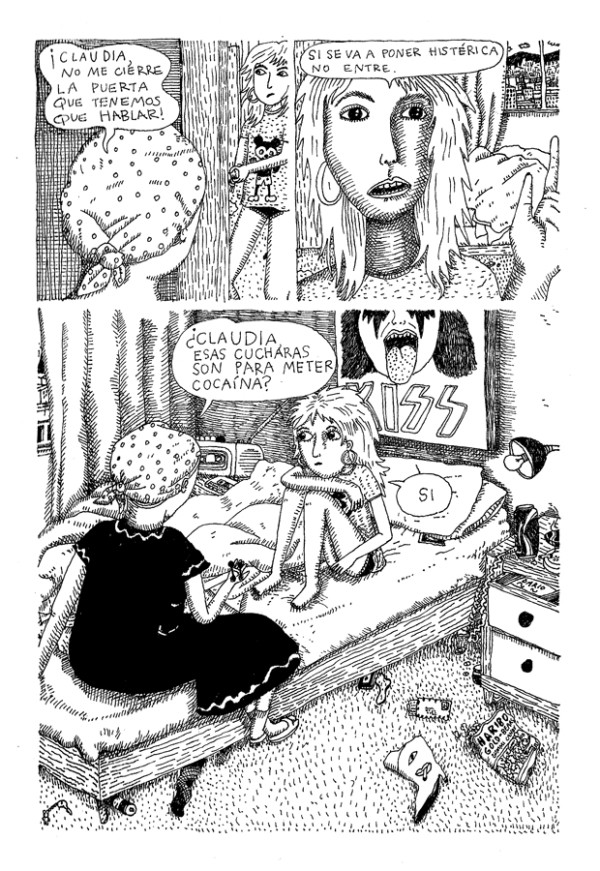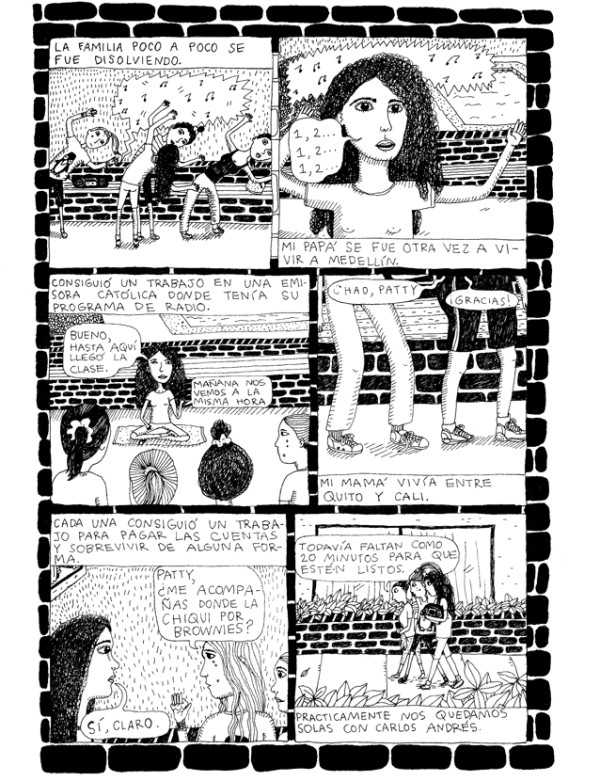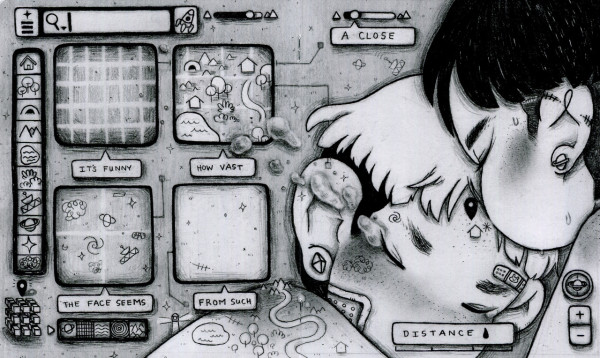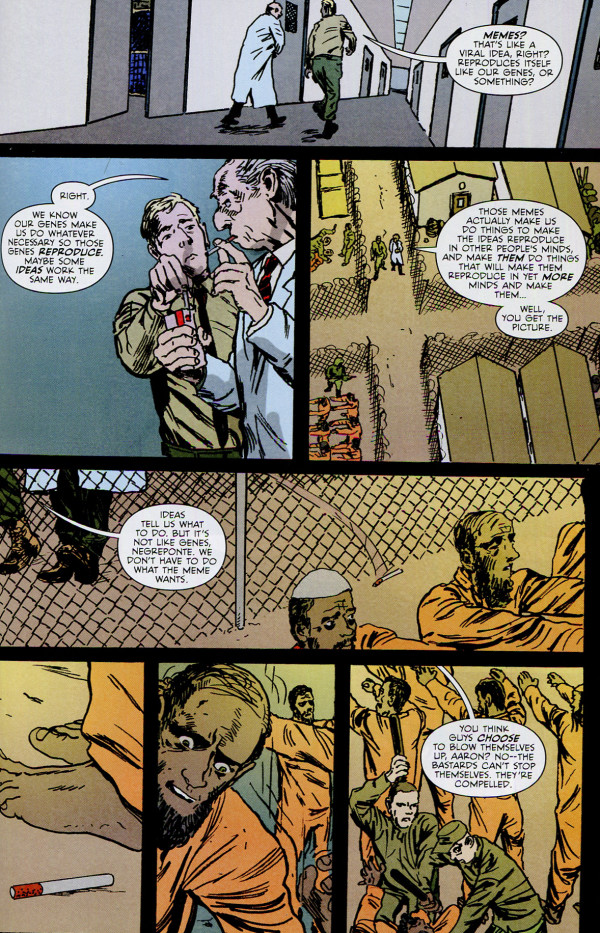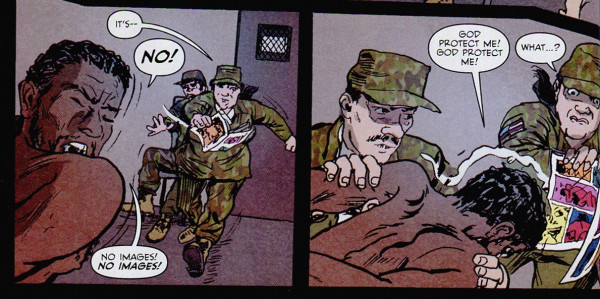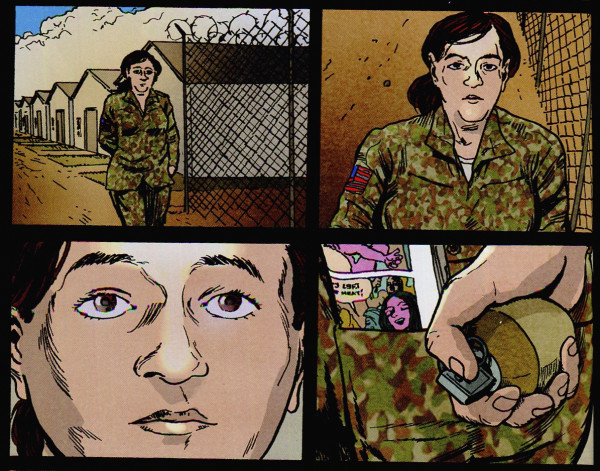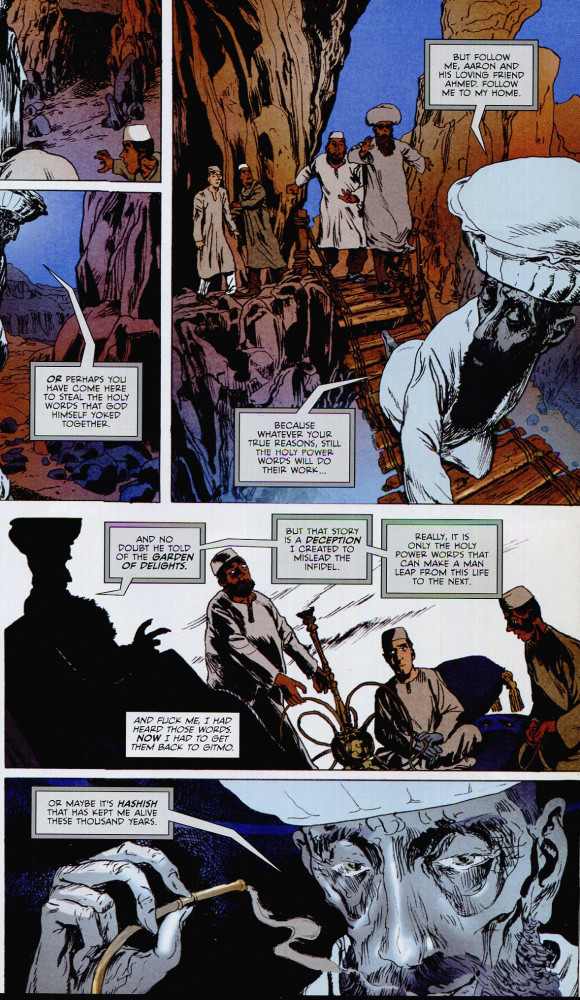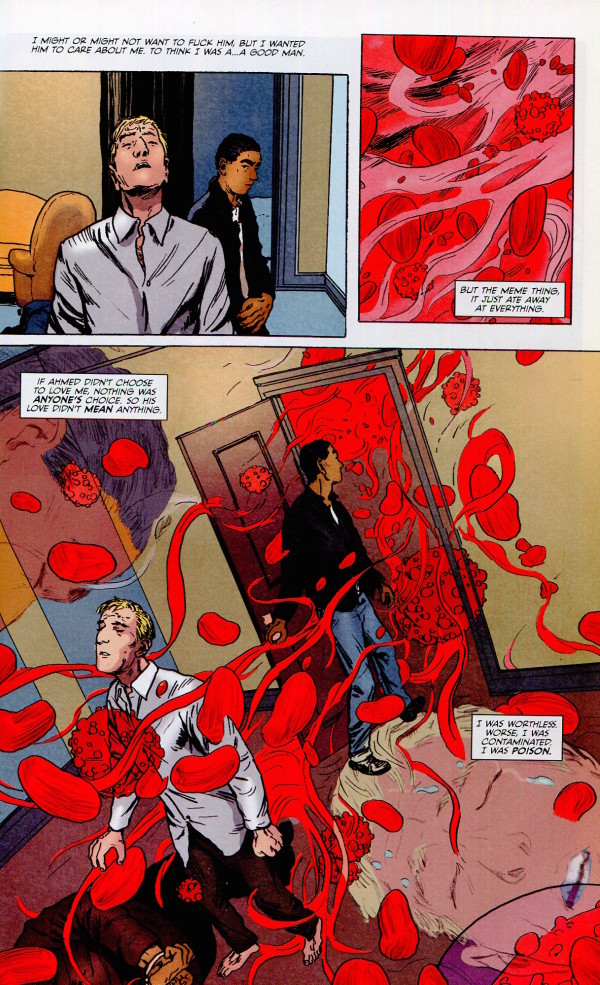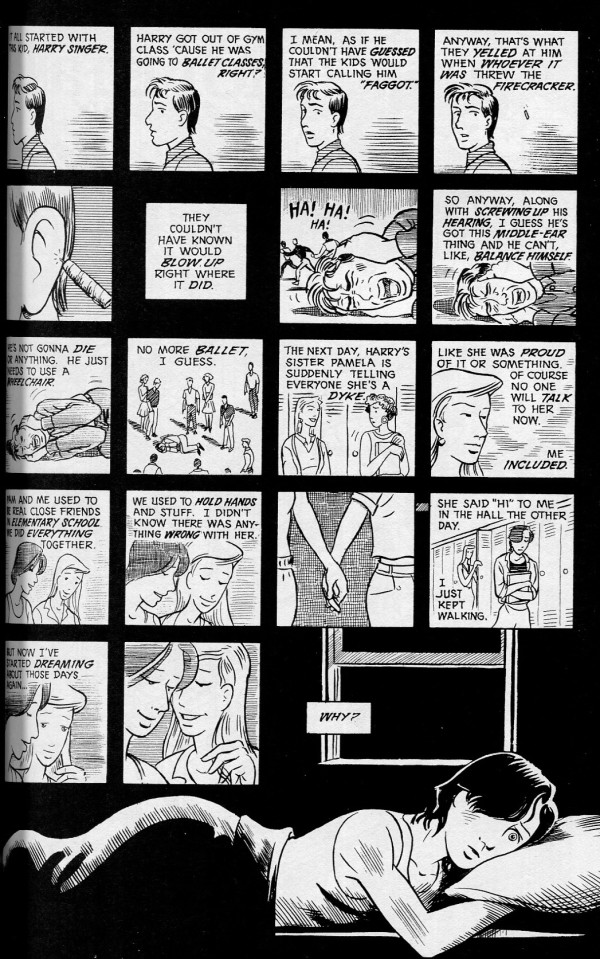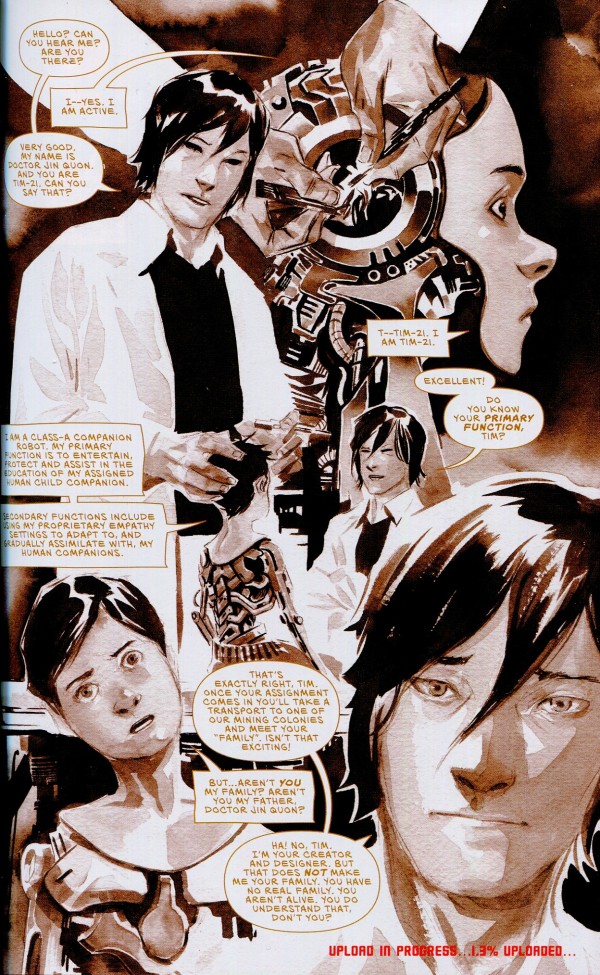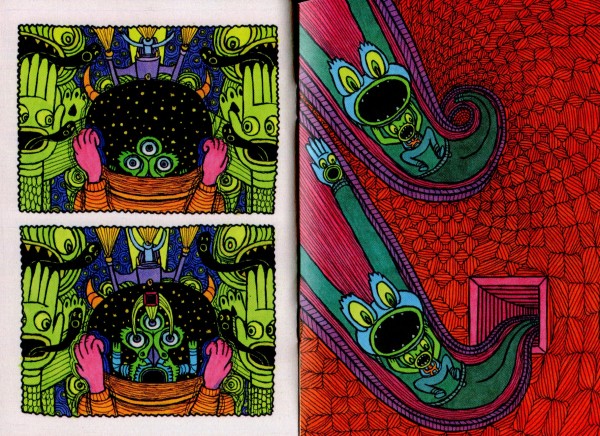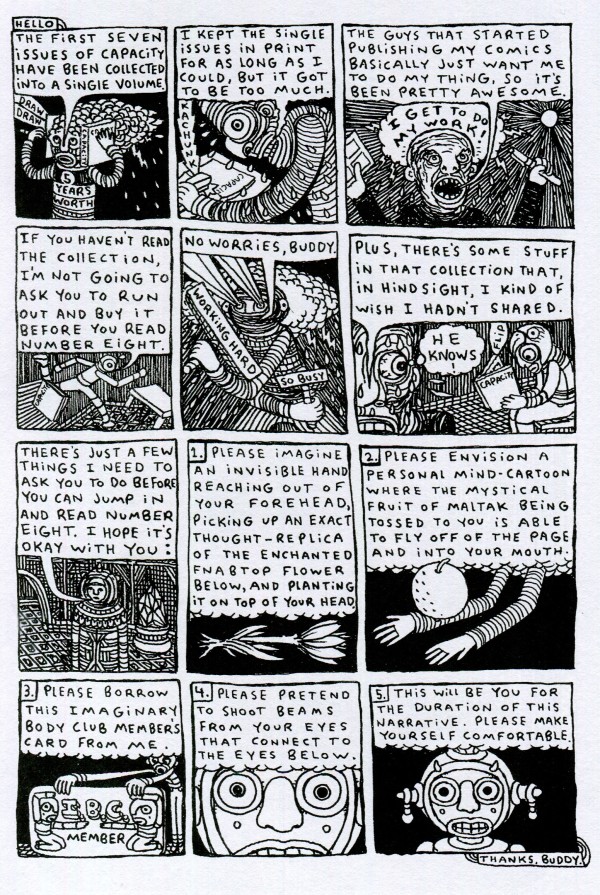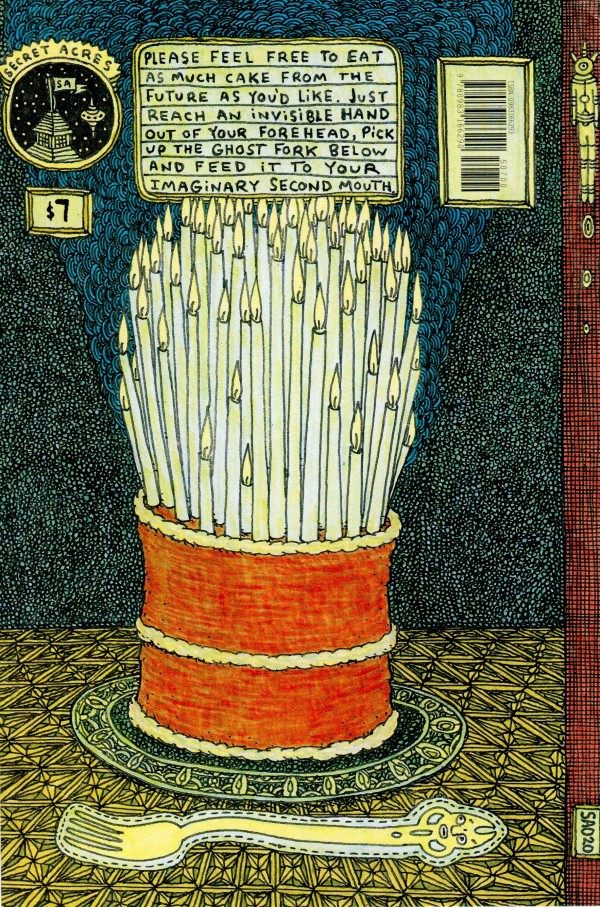The bad news is I’m sitting in an empty room while all my books (and most of the rest of my stuff) is in an entirely different house. This is because moving is hard and I’m bad at planning.
Thankfully, I have a lot of crowdfunded comics to look forward to once I get my change of address form all filled out. Here are two upcoming releases that I’m eager to have dropped in my brand new mailbox.
Sure, the Kickstarter is over, but that just means you can buy all these books directly from 2dcloud.com. This “season” of books fits perfectly together, though, so you should definitely read them all. Here’s the excellent lineup:
- Turning Japanese by MariNaomi
- Someone Please have Sex With Me by Gina Wynbrandt
- Virus Tropical by Powerpaola
- Trying Not to Notice by Will Dinski
I’ve had the pleasure of seeing both MariNaomi and Gina Wynbrandt read excerpts from these releases. Both are brutally honest about their lives and their desires, but that honesty is coupled with so much kindness and humor and empathy that they’ll flat out break your heart. Also, Mari’s lettering is the most immaculate in the business, and Gina’s neon colors make her comics feel like Lisa Frank’s bad trips.
Of all the books, Virus Tropical is the one I know the least about. The description is great, though:
Powerpaola uses a series of vignettes to transform the simplicity of middle-class family life into a thought-provoking narrative that would have been inconceivable prior to Colombia’s sexual revolution. Focusing on the lives of a family of women in the 80’s-90’s, Powerpaola’s tale highlights the excitement, danger, and struggles of a country in the midst of radical change.
And Powerpaola’s mark-making feels passionately obsessive. Just take a look at these preview pages:
And Will Dinski is just a gentleman of indie comics. His older work comprises a body of flawless minicomics, each one an attentively designed art object. For instance: a comic about maps that unfolds like an atlas; a comic about taking a Scientology test that is built around a scan of the test results; and some careful screenprinted covers with glow-in-the-dark ink. But I’ve heard that Trying Not to Notice features a much looser, less controlled Will Dinski, which is an exciting style to look forward to.
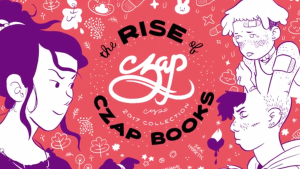 The Rise of Czap Books—The 2017 Collection
The Rise of Czap Books—The 2017 Collection
This one’s still going! Give Czap Books your money right here. The lineup:
- Witchlight by Jessi Zabarsky
- don’t tell me not to worry (i’ll worry all i want) by Kelly Kwang
- Egg Creme #1 by Liz Suburbia
Aw, dang, if only I had my comic collection and my personal computer. Then I could show you some excellent screen caps from Zabarsky’s digitally released Witchlight serial. Even then, it wouldn’t matter since Zabarsky’s remastering them for the book release. Hop over to the Kickstarter to see her exceptional choreography and intricate mapping. It’s about a witch and her kidnapped sidekick—a perfect fantasy setup.
Similarly, if I had my full computer setup, I’d show you Kelly Kwang’s quiet, grainy renditions from Frontier #12, a short comic all about the cosmic loneliness of the Space Youth Cadets. Here’s the only image I have access to:
See that quiet concern? That loving reproduction of digital aesthetics? That airbrush feel of love lived and lost? That’s what you can look forward to in don’t tell me not to worry.
And as for Liz Suburbia’s work, well, it has a feel of primal punk cartooning. Egg Creme is a sequel to the hit Sacred Heart, and the ink on the preview pages looks like it was applied with an angry razor despite its clear storytelling.
So there you go! It’s one million degrees here in Minnesota, and I’m stuck on the second story of a dirty, croaking house with none of my books. And you, dear readers? In these dog days of summer, what kind of literary comfort are you looking forward to?
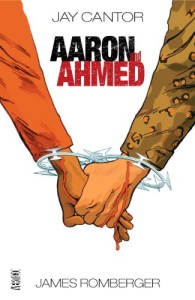 Aaron and Ahmed by Jay Cantor & James Romberger (Vertigo, 2011)
Aaron and Ahmed by Jay Cantor & James Romberger (Vertigo, 2011)
The PR line for Aaron and Ahmed, repeated in all its blurbs, is, “What causes terrorism?” It’s the starting point for the story written by Jay Cantor and drawn by James Romberger; the point-of-view character, Aaron Goodman, loses his wife in the terrorist attacks of 9/11. Aaron signs up to be an Army doctor and finds himself in Gitmo, working with another doctor who’s trying to find a root cause for terrorism no matter the cost.
Aaron begins holding private interview sessions with Ahmed, one of the prisoners, lacing his food with estrogen to create a romantic bond which, as far as I can tell, is not a real thing (except for that one attempt with Hitler). It’s a pop psychology, sci-fi departure from the serious and realistic material, and as strange as it is, it’s nowhere near as opaquely dumb as what follows.
Aaron’s superior decides that memes are behind terrorism—that the chanting of Muslim fanatics somehow infect the minds of terrorists with an idea virus that causes them to become suicide bombers. Aaron and Ahmed begin to trust each other, and Aaron decides that the only way to uncover the cause of terrorism is to travel with Ahmed to meet with a possibly mythical leader of Middle Eastern suicide bombers.
Without spoiling the ending, what follows is maybe proof of Aaron’s meme theory or maybe a psychological play on his damaged psyche after witnessing his wife’s death and the horrors of Gitmo. However, the narration, provided mostly by Aaron’s internal monologue with occasional incursion by the Old Man of the Mountain, focuses entirely on Aaron’s belief that he’s being taken over by the meme virus of terrorism.
It’s frankly obnoxious. Instead of exploring the real-life cultural, socioeconomic pressures exerted on the Middle East, Cantor’s script follows a white man’s sadness and his tragic struggle. It’s a version of Dances With Wolves, where the American soldier becomes an even better Muslim than his Muslim friend, being chosen over Ahmed to become a suicide bomber. The real-life catalysts of terrorism—oil wars, installed dictators, Cold War tensions—are mentioned throughout, but it feels like lip service in the onslaught of meme talk.
And it’s a strange thing, because another important aspect of the book is the power of words. Chants and prayers, in Cantor’s meme philosophy, are rhythmic deluges of words that infect those that hear them, turning them into suicide bombers. So using the meme narrative—using all the words in the comic to describe the sci-fi theory—in lieu of the more realistic possibilities is an odd choice. Is Cantor saying that only fantastical words can infect people with large ideas? That his meme ideas are akin to the prayers, and he’s hoping to infect us with his story?
Once a potential suicide bomber is infected by the chants of the Old Man of the Mountain, it takes an image to activate their programming. This is perhaps the most interesting part of the book since we’re dealing with a comic—a story that puts the lie to any kind of false dichotomy between image and picture.
Both Aaron and an unnamed prisoner talk about being activated by images, but a comic book also plays a big part in the plot. In possession of a jailer, it inspires soldiers to demean and abuse a prisoner. It’s taken away by one of the soldiers, though, and she scolds the others. Later on, she commits suicide with a grenade, effectively becoming a suicide bomber in the process, and her possession of the comic is repeatedly highlighted.
Maybe Cantor is trying to say that a comic—a potent combination of word and image—can mainline the meme infection. It only takes a few days for the soldier to go from paragon of her career, tempering the more violent soldiers, to suicide bomber. Is Cantor saying that comics are bad for people? Or is it just that we only see “bad” literature—trashy comics, fanatical chants—in action? (There is a small subplot where soldiers are reading “good” literature to prisoners in an attempt to counteract their programming, but that plot remains unresolved.)
A word on Aaron and Ahmed‘s images: they are the best part of the book. Romberger has been a great cartoonist for years, at least since his work on 7 Miles a Second (an intensely personal and apocalyptic book that faces contemporary issues in a way that puts Cantor’s script to shame). It’s Romberger’s art that makes the characters of Aaron and Ahmed actually feel like people; his soft, at times almost squishy anatomy balances out Cantor’s cold and clinical script.
Especially amazing are Romberger’s portrayals of the more fantastical scenes. Where Cantor’s script hammers at the sci-fi elements, Romberger’s drawings, such as of the Old Man of the Mountain and Aaron’s impending infection, are have a softer, subjective feel to them. They’re much more subtle than Cantor’s script, even at their most tortured and lurid. They’re helped, of course, by the balanced colors by José Villarrubia.
Cantor’s obsession with the interplay between words and images rings false in light of this book. It would have been much better as a wordless comic.
How about you, readers? Have you ever loved part of a book but hated another?
My reading habits have been sporadic and random lately. I’m like a springtime forager just eating whatever blooms and stalks I see after a winter of being too busy to choose my reading carefully.
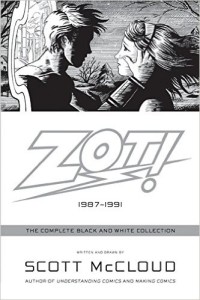 Zot! The Complete Black and White Collection by Scott McCloud (Harper, 2008)
Zot! The Complete Black and White Collection by Scott McCloud (Harper, 2008)
Zot! is the comic that probably put Scott McCloud, famed comics scholar, on the national map. It was his longest fictional work, and it was completed as he was starting Understanding Comics, the first of his books about comics as an artform.
I confess to an inflated expectation, then, in regards to McCloud’s formative work—would it employ all of the formal tactics he codified in his critical writings?
The answer, surprisingly, is yes. Zot! has great pacing and playful structuring, often breaking the narrative into interesting slices of time and point of view:
Unfortunately, the story that these tricks serve vacillates between bland and melodramatic. It follows teen science hero Zot, paragon of a parallel Earth, and his romance with pessimistic Jenny, stuck in our humdrum world. Her negative outlook is only exacerbated by knowledge of Zot’s fantastic utopia, and the tension in their relationship comes from her desire to escape her everyday life and Zot’s insistence that any world, any culture, is beautiful and worth saving. It’s a good starting point, but it often boils down to Jenny yelling or weeping while Zot looks on stoically. His childish naiveté fits his character, but it also means that no one really tells Jenny why leaving the less lucky of her world for the fantastic sci-fi life would be a gross exercise of her privilege.
McCloud himself notes that some of his morals come off a little heavy-handed, comparing them to afterschool specials. This sentiment is coupled with a dismissive attitude toward the superhero aspects of the story, namely Zot and his super-science. However, the exceptionally melodramatic aspects of the series only get worse as Zot’s world is phased out and McCloud focuses on the everyday.
It turns out that when a kid is flying around with a laser gun and rocket boots, it’s easier to mythologize the story—since there are aspects that readers know aren’t real, it can be fun to draw parallels and assign allegories to the cast and the story. When McCloud decided to take things in a “literary” direction, his characters and dialogue began to crumble under the weight of the issues he was tackling. Maybe the problem lies in writing toward those said issues—crime, coming out, divorce—instead of focusing on the characters.
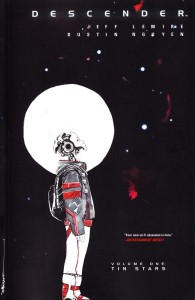 Descender: Tin Stars by Jeff Lemire and Dustin Nguyen (Image Comics, 2015)
Descender: Tin Stars by Jeff Lemire and Dustin Nguyen (Image Comics, 2015)
As a standalone volume, Tin Stars wasn’t great. It introduces a futuristic sci-fi galaxy that hates robots after a mysterious mechanical attack. One of the last robots, a boy-shaped droid named Tim-21 who was made for friendship, might have connections to the event that kicked off the robot genocide. He and his dog-bot, then, are on the run from two factions in the galactic government. Who will catch him? Are their intentions what they seem? And what is Tim-21’s link to the giant robots that have irrevocably damaged galactic culture?
By the end of Tin Stars, I found myself not really caring about the answers to these questions. Nearly all of the characters felt like bland stereotypes: the naive artificial boy looking for his human friend, the cute animal sidekick, the soldier woman with something to prove, the deadly thug with a heart of gold, the pig-like villains with no morals—it felt like an outline for a summer blockbuster. It didn’t help that the book was riddled with typos, from misspelling characters’ names to freely swapping out exclamation points and question marks.
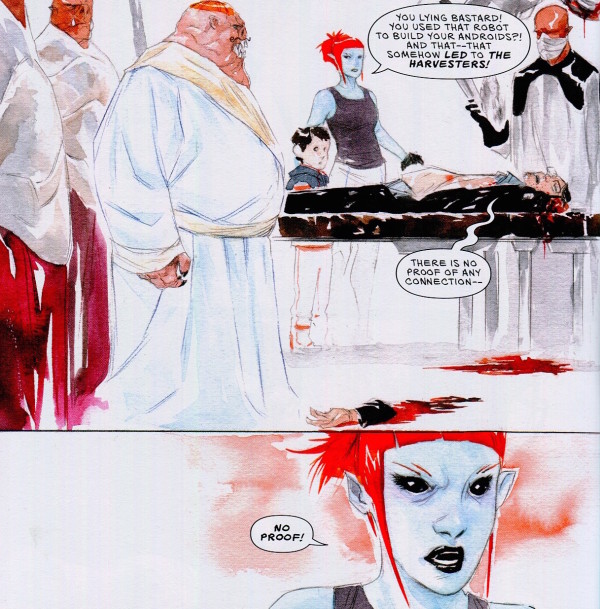
I’m 99% sure she’s doubting his statement, but with that exclamation point, she could be vehemently agreeing.
Future volumes might develop these characters more. Indeed, the one character who gets an extended flashback, Dr Quon, becomes an interesting, flawed, and driven guy once his secrets are exposed. I’m just not sure I’m ready to wade through the typos and stereotypical dialogue to reach that point.
It’s too bad, too, because the art by Dustin Nguyen is beautiful. He makes even the most cluttered pages readable, and he uses spare brushstrokes that convey a surprising amount of information. His designs and facial expressions do a lot of the heavy lifting in the character development department.
The story reads fast enough that a collection of 10 or 12 issues wouldn’t have been intimidating. If the characters get some development in the next few chapters, I’d have happily kept reading. Are these things considered by collection editors?
 The Autumnlands: Tooth & Claw by Kurt Busiek, Ben Dewey, and Jordie Bellaire (Image Comics, 2015)
The Autumnlands: Tooth & Claw by Kurt Busiek, Ben Dewey, and Jordie Bellaire (Image Comics, 2015)
All I knew about this comic going in was that it was about animal people. On that level, it did not disappoint. In fact, the book did not disappoint at any level.
Despite having a cast of dozens, Busiek and Dewey use an inseparable combination of character design (animal choice, clothing, posture) and dialogue to establish personality and motivation quickly and firmly. The world—a place of dying magic, floating cities, and aristocracy and oppression—is explained at a natural pace.
Some fantasy and sci-fi can feel like being led through a museum of the creators’ ideas; their worlds are static, relayed through bursts of exposition. This is not the case with Autumnlands. These toys aren’t precious to their owners, and they’re freely deconstructed, deposed, and disposed of. There’s a central conceit to the story—a sci-fi twist to the Wizards of Redwall status quo that I hesitate to spoil—is almost just set dressing for the drama and politics of the rest of the book.
Dewey’s art is slick and clear with lush ink work, and it’s impossible to talk about it without mentioning Jordie Bellaire’s color. There are a lot of sepias and earth tones, but it’s far from muddy; Dewey’s sharp lines keep things clear, and Bellaire uses splashes of bright color for the rich clothing, magic spells, and (spoiler warning) blood.
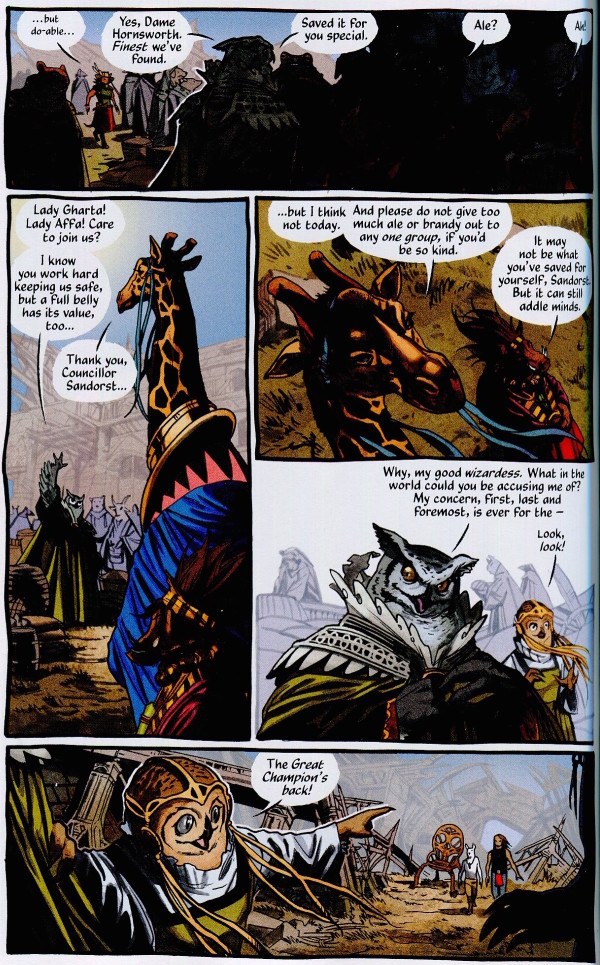
The evil character at the top is surrounded by inky darkness that slowly gives way to browns and then bright colors as the hero returns.
How about you, readers? What do you read when you’re grazing? And do you regret those choices later?
What We’re Reading: Theo Ellsworth

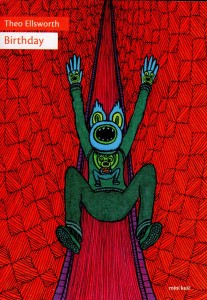 Birthday (mini kuš! #35) and Capacity #8 by Theo Ellsworth (Secret Acres, kuš! komiksi, 2015)
Birthday (mini kuš! #35) and Capacity #8 by Theo Ellsworth (Secret Acres, kuš! komiksi, 2015)
The only text relevant to Theo Ellsworth’s Birthday is on the back cover: “Our hero is insanely nervous. He’s about to undergo an intense psychic initiation known as the Inner-Space Birth Ritual. You’d be nervous, too!” From there, we’re on our own.
Luckily, Ellsworth’s art is filled with patterns of parallel lines and nested ornamentation, making each page feel like a woodcut. The level of detail combined with a complete lack of text encourage one to linger on every panel. The characters feel organically modular: the protagonist’s cloud of anxiety is dispelled to a fish mouth and replaced by a small spaceship-cum-hat. Later, inside a Birth Ritual Helmet, faces flash and change across its starry surface.
In the end, the protagonist is reduced (symbolically?) to a baby, cradled by a massive, smiling creature-structure. The Birth Ritual seems successful, and perhaps the baby has personified and utilized his negative aspects in the process; “process” is the key word here, since the book is more a process than a story. The minimalism is implicitly inviting.
On the other hand, Capacity is explicitly inviting. If Birthday is an organic or ritual process, Capacity is a mechanical one. Ellsworth invites the reader to his 1412th birthday, transporting them through space and time via thought-replicas of fnabtop flowers, a fruit of maltak, and an imaginary body. Dressed in his best wolfman self, Future Ellsworth relates the drastic ways in which the earth will change over the next 1,400-odd years. He explains imaginary hyper-intelligence beans, personal-mind-configuration keys, multi-dimensional time-crystals, and mind-weather starters.
In contrasting the two books, I initially felt that Birthday was like witnessing a miracle whereas Capacity was closer to reading the Bible (or having the Bible explained to you), but there’s something banal in the assumptions behind that comparison. Who wouldn’t choose to witness the miracle?
But I found myself enjoying Capacity a bit more. Reading it felt like being equipped with the tools to understand future miracles and to maybe even make my own.
Does dismantling sets of symbolism reduce their effectiveness? Or can explanation lead to further mysteries?


